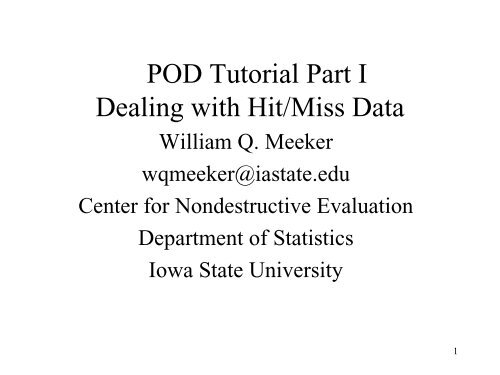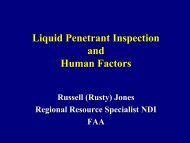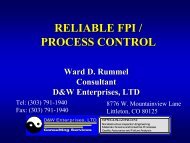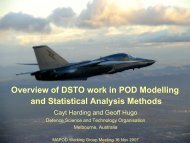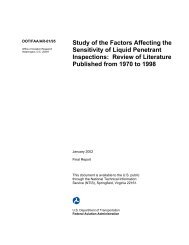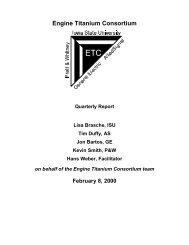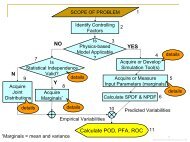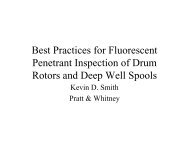POD Tutorial Part I Dealing with Hit/Miss Data - Center for ...
POD Tutorial Part I Dealing with Hit/Miss Data - Center for ...
POD Tutorial Part I Dealing with Hit/Miss Data - Center for ...
You also want an ePaper? Increase the reach of your titles
YUMPU automatically turns print PDFs into web optimized ePapers that Google loves.
<strong>POD</strong> <strong>Tutorial</strong> <strong>Part</strong> I<br />
<strong>Dealing</strong> <strong>with</strong> <strong>Hit</strong>/<strong>Miss</strong> <strong>Data</strong><br />
William Q. Meeker<br />
wqmeeker@iastate.edu<br />
<strong>Center</strong> <strong>for</strong> Nondestructive Evaluation<br />
Department of Statistics<br />
Iowa State University<br />
1
Empirical <strong>POD</strong><br />
Broad Overview<br />
• <strong>POD</strong> from <strong>Hit</strong>-<strong>Miss</strong> <strong>Data</strong><br />
• <strong>POD</strong> ahat versus a<br />
• Advanced Topics in Empirical <strong>POD</strong><br />
2
<strong>Dealing</strong> <strong>with</strong> <strong>Hit</strong>/<strong>Miss</strong> <strong>Data</strong><br />
• What is <strong>POD</strong>?<br />
• What is PFA?<br />
• Sources of data<br />
• <strong>Hit</strong>/<strong>Miss</strong> data<br />
Overview<br />
• Binary regression model <strong>for</strong> <strong>Hit</strong>/<strong>Miss</strong> data<br />
• <strong>POD</strong> from the binary regression model<br />
3
What is <strong>POD</strong>???<br />
• Probability of Detection<br />
• Fraction of flaws, in a large number of inspections,<br />
that will be detected<br />
• May be (and typically is) conditional on flaw<br />
characteristics (e.g., size and depth)<br />
• By making model assumptions, can be expressed as<br />
part of a probability or statistical model<br />
• <strong>POD</strong> will depend on the detection rule (threshold)<br />
4
What is PFA???<br />
• Probability of false alarm<br />
• Fraction of inspection opportunities, in a large<br />
number of inspections, that will call a<br />
“detect” when no flaw is present<br />
• Will depend on the noise level and threshold<br />
• Definition of “inspection opportunity” is<br />
important (what is the denominator?).<br />
Consider the extremes:<br />
per <strong>for</strong>ging<br />
per pulse on a <strong>for</strong>ging UT inspection?<br />
5
<strong>POD</strong> Studies<br />
(Sources of <strong>POD</strong> <strong>Data</strong>)<br />
• Designed experiments<br />
• Field finds<br />
6
Designed Experiments<br />
• Most common <strong>for</strong>m of <strong>POD</strong> data (in my<br />
experience)<br />
• Need a collection of representative flaws. Possible<br />
choices:<br />
– Real<br />
– Synthetic simple (flat bottom hole, notch, synthetic<br />
hard alpha)<br />
– Synthetic realistic (fatigue cracks)<br />
• Conduct inspection experiment on the specimens<br />
7
Field-Find <strong>Data</strong><br />
• Typically only a limited number of field<br />
finds in most applications<br />
• Need careful flaw characterization (e.g.,<br />
sizing)<br />
• Must use special statistical methods<br />
(truncated regression) to account <strong>for</strong> misses<br />
8
<strong>Data</strong> Giving <strong>Hit</strong>/<strong>Miss</strong> versus<br />
Flaw Size<br />
• For each inspection opportunity on a unit<br />
<strong>with</strong> a known flaw, we have a detect (<strong>Hit</strong>)<br />
or not (<strong>Miss</strong>)<br />
• Model <strong>POD</strong> as a function of flaw size<br />
• Frequently used in FPI <strong>POD</strong> estimation<br />
where good quantitative data is not<br />
available<br />
9
Sonic IR <strong>Hit</strong>/<strong>Miss</strong> <strong>Data</strong><br />
Sample<br />
Crack<br />
number Detectable? Length<br />
1 0 0.0125<br />
2 1 0.032<br />
3 0 0.0075<br />
4 0 0.016<br />
5 1 0.025<br />
6 0 0.0096<br />
7 0 0.0215<br />
8 0 0<br />
9 1 0.038<br />
10 0 0.0125<br />
11 0 0.0085<br />
12 1 0.021<br />
13 1 0.028<br />
68 1 0.036<br />
69 1 0.0205<br />
70 0 0.012<br />
10
Estimation of <strong>POD</strong><br />
from <strong>Hit</strong>\<strong>Miss</strong> <strong>Data</strong><br />
• Model <strong>POD</strong> as a function of flaw size (or<br />
other characteristic(s))<br />
• The appropriate statistical technique is<br />
“binary regression.”<br />
• Common models used in binary regression<br />
are the “logistic model” and the “probit<br />
model.”<br />
11
<strong>POD</strong> Estimate from FPI <strong>Hit</strong>/<strong>Miss</strong> <strong>Data</strong><br />
12
Binary Regression Model<br />
• Pr(<strong>Hit</strong>) is a function of flaw size. Commonly:<br />
⎛log( a)<br />
- μ ⎞<br />
<strong>POD</strong>( a) = Pr(<strong>Hit</strong>) = Φ ⎜ ⎟=Φ<br />
( β0 + β1log(<br />
a))<br />
⎝ σ ⎠<br />
• Use Maximum likelihood (ML) to estimate the<br />
parameters β0 = −μ/ σand<br />
1 . 1/ β σ =<br />
– For logit Φ ( z) = exp( z) /(1+ exp( z))<br />
– For probit Φ(<br />
z)<br />
is the standard normal cumulative<br />
distribution function.<br />
13
MINITAB Estimation of Binary<br />
Regression Model Parameters<br />
• The MINITAB “Logistic regression” procedure<br />
will estimate the parameters β0 and β1.<br />
• After the parameters have been estimated, <strong>POD</strong><br />
(and possibly confidence intervals) could be<br />
obtained by<br />
– Writing a MINITAB macro<br />
– Importing results to Excel and writing a macro or<br />
procedure there<br />
– Using other simple software (e.g. MATLAB).<br />
14
MINITAB Worksheet Sonic IR <strong>Hit</strong>/<strong>Miss</strong> <strong>Data</strong><br />
(blank specimens removed)<br />
Sample number Detected CrackLength Log10CrackLength<br />
1 0 0.0125 -1.90309<br />
2 1 0.0320 -1.49485<br />
3 0 0.0075 -2.12494<br />
4 0 0.0160 -1.79588<br />
5 1 0.0250 -1.60206<br />
6 0 0.0096 -2.01773<br />
7 0 0.0215 -1.66756<br />
9 1 0.0380 -1.42022<br />
67 0 0.0125 -1.90309<br />
68 1 0.0360 -1.44370<br />
69 1 0.0205 -1.68825<br />
70 0 0.0120 -1.92082<br />
15
MINITAB Binary Regression Output<br />
Binary Logistic Regression: Detected versus Log10CrackLength<br />
Link Function: Logit<br />
Response In<strong>for</strong>mation<br />
Variable Value Count<br />
Detected 1 30 (Event)<br />
0 30<br />
Total 60<br />
Logistic Regression Table<br />
95% CI<br />
Predictor Coef SE Coef Z P Odds Ratio Lower<br />
Constant 47.7243 14.2260 3.35 0.001<br />
Log10CrackLength 27.0323 8.07139 3.35 0.001 5.49512E+11 74040.28<br />
<strong>POD</strong> a ˆ ˆ a a<br />
ˆ ( ) =Φ ( β0 + β1log<br />
10( ))= Φ (47.72 + 27.03× log 10(<br />
))<br />
16
<strong>POD</strong> a ˆ ˆ a a<br />
<strong>POD</strong><br />
ˆ ( ) =Φ ( β0 + β1log<br />
10( ))= Φ (47.72 + 27.03× log 10(<br />
))<br />
1.0<br />
0.8<br />
0.6<br />
0.4<br />
0.2<br />
0.0<br />
0.005 0.015 0.025 0.035<br />
Crack Size a<br />
17
Logistic Model <strong>POD</strong> 95% Confidence Limits<br />
(pointwise and simultaneous)<br />
18


